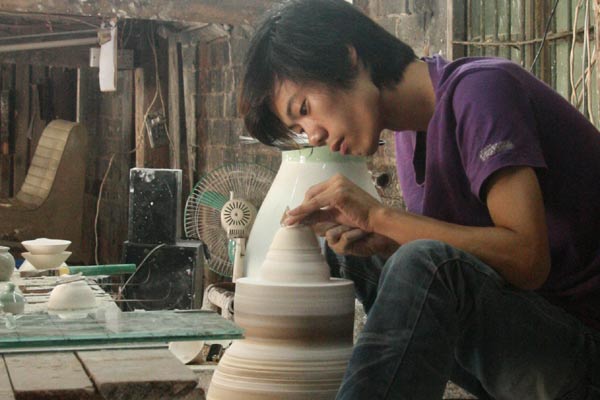'Porcelain capital' hopes to rekindle age of beauty
Updated: 2012-04-10 07:38
By Yang Wanli (China Daily)
|
||||||||
White like jade
Unlike jade ornaments, made from precious stone, and carrying an intrinsic value, porcelain is valued not for the cost of the raw materials, but for the craftwork on display. Over the years, Jingdezhen porcelain has developed four special characteristics: It's white like jade, as bright as a mirror, as thin as paper and it chimes when struck softly.
Today, however, Jingdezhen's porcelain has a reputation for poor quality. The city's 4,000 individual workshops produce identikit goods of varying quality. Some inferior wares, branded "Made in Jingdezhen", have been sold at extortionate prices overseas, but that has sometimes resulted in countries refusing to grant entry visas to the city's merchants to discourage such trade.
The city's porcelain industry failed to develop after the Qing Dynasty and went into almost terminal decline in the 1990s, when its 10 State-owned factories closed during the national enterprise reforms, resulting in tens of thousands of artisans losing their jobs. A handful opened workshops, but most went out of business because the scale of production was so small. Without the continued practice, their skills were lost.
 |
|
A man makes a cup at a ceramics workshop in Jingdezhen, Jiangxi province. Known as China's "Capital of Porcelain", the city is now struggling to recapture its former glory. [Wang Hao / China Daily] |
"The factory developed out of the old imperial kilns. When it opened in 1952, it was the city's largest porcelain works. Workers there were admired because they earned nearly twice the average wage of other industries. The porcelain we made was presented as gifts to foreign leaders at the time," recalled Wang proudly.
A lack of creativity, allied to a poor competitive edge, resulted in the factory going bankrupt in the late 1990s, with only one of every 10 workers remaining in the industry. "But a private workshop is a hard place to make a profit, because of the small scale of production. Most of the workers eventually turned to other jobs, and their skills simply weren't passed on," he said.
Wang took a job at the Ancient Kiln Customs Museum, showing visitors how to make clay into bases, usually for bowls. He earns about 2,000 yuan ($317) a month, roughly as much as the average middle-school teacher.
Like Wang, 10 or more other highly experienced artisans also make a living working at the museum, repeatedly demonstrating a single step in the production process to visitors. Their skills are now simply for show, rather being part of the delicate process of creating high-quality ceramics.
The skills involved in the production of porcelain are traditionally handed on through the master-apprentice system, but Wang has only three apprentices. His 15-year-old grandson is the youngest, but he spends most of his time in school rather than perfecting his skills.
Unlike European craftsmen, who used the same basic set of ingredients but added variations in terms of colors and shapes, most Chinese artisans make their wares using a closely guarded recipe, usually passed down through generations of the same family. Although Wang realizes that a lack of interested young people will mean his skills will eventually die, he is adamant that he will continue with the master-apprentice system.

 Relief reaches isolated village
Relief reaches isolated village
 Rainfall poses new threats to quake-hit region
Rainfall poses new threats to quake-hit region
 Funerals begin for Boston bombing victims
Funerals begin for Boston bombing victims
 Quake takeaway from China's Air Force
Quake takeaway from China's Air Force
 Obama celebrates young inventors at science fair
Obama celebrates young inventors at science fair
 Earth Day marked around the world
Earth Day marked around the world
 Volunteer team helping students find sense of normalcy
Volunteer team helping students find sense of normalcy
 Ethnic groups quick to join rescue efforts
Ethnic groups quick to join rescue efforts
Most Viewed
Editor's Picks

|

|

|

|

|

|
Today's Top News
Health new priority for quake zone
Xi meets US top military officer
Japan's boats driven out of Diaoyu
China mulls online shopping legislation
Bird flu death toll rises to 22
Putin appoints new ambassador to China
Japanese ships blocked from Diaoyu Islands
Inspired by Guan, more Chinese pick up golf
US Weekly

|

|






